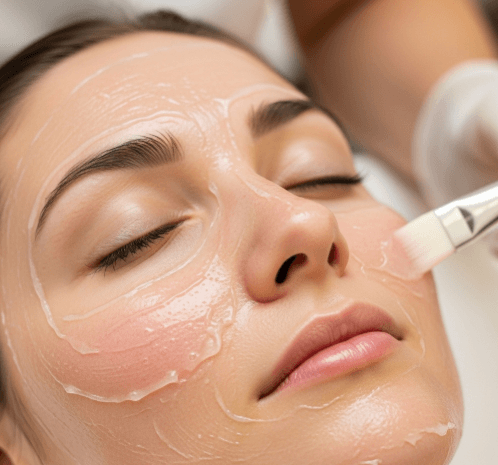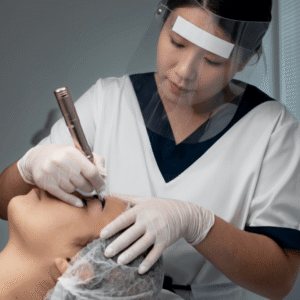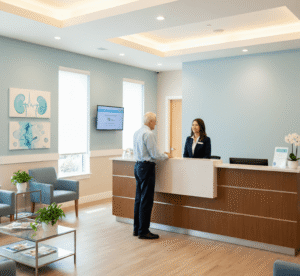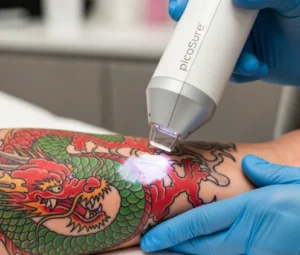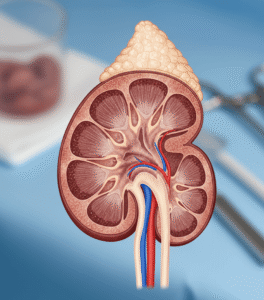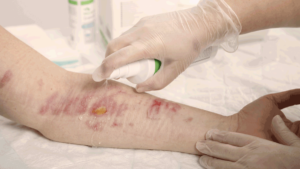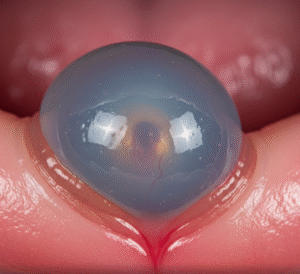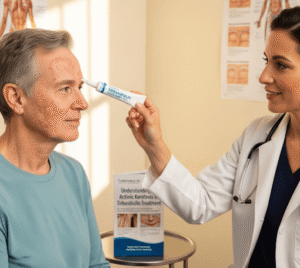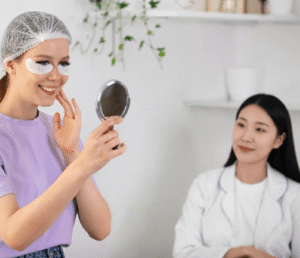What it is in Korea
➤ Glycolic peel in Korea is a dermatological treatment that uses glycolic acid (an alpha-hydroxy acid, AHA) to gently exfoliate the skin, stimulate cell turnover, and improve acne, pigmentation, and texture.
→ Glycolic acid, derived from sugarcane, has the smallest molecular size among AHAs, allowing it to penetrate the skin effectively.
✦ In Korean dermatology, glycolic peels are widely used for:
- Mild to moderate acne
- Hyperpigmentation and melasma
- Uneven skin tone and dullness
- Fine lines and early aging signs
✔ Unlike spa facials, glycolic peels in Korea are medical-grade treatments, performed under dermatologist supervision for safety and effectiveness.
Why it’s done in Korea
▸ Medical reasons → Glycolic peels treat acne by unclogging pores and reducing excess keratin buildup.
▸ Aesthetic reasons → Clear, glowing skin is highly valued in Korea, and glycolic peels are a quick way to restore radiance.
▸ Preventive reasons → Regular treatments help maintain skin clarity and slow visible signs of aging.
✔ Dermatologists in Korea recommend glycolic peels when:
- Patients suffer from post-acne dark spots
- Skin looks dull, uneven, or rough
- Fine wrinkles or early aging signs are visible
- Patients want gentle yet effective exfoliation with minimal downtime
Alternatives in Korea
Although glycolic peels are popular, alternatives or complementary treatments may be used depending on the condition:
➤ Other chemical peels
- Salicylic peel → better for oily, acne-prone skin
- Jessner’s peel → treats both acne and pigmentation
- TCA peel → deeper peel for scars and severe pigmentation
➤ Topical & oral therapies
✔ Retinoids → stimulate collagen and cell turnover
✔ Hydroquinone → lighten dark spots
✔ Isotretinoin → for severe acne unresponsive to peels
➤ Procedural options
✦ Laser toning → brightens pigmentation and smooths texture
✦ Microneedling → stimulates collagen for scars and wrinkles
✦ Cystic acne injection → reduces painful nodules
Preparation in Korea
Before undergoing a glycolic peel, Korean dermatologists guide patients on preparation:
▸ Skin preparation
→ Stop using retinoids, scrubs, or acids 5–7 days before the procedure.
→ Maintain a hydrated, simple skincare routine (gentle cleanser + moisturizer).
▸ Lifestyle considerations
✦ Avoid sunburn or tanning before treatment.
✦ Inform the doctor about allergies, medications, or pregnancy.
▸ Consultation
✔ Korean dermatologists assess skin type, tone, and condition to determine the proper glycolic concentration (commonly 20–70%).
✔ A patch test may be done for sensitive skin.
How it’s done in Korea
The glycolic peel procedure is quick, often completed in 20–30 minutes:
- Cleansing → The skin is cleaned thoroughly.
- Application → A measured glycolic acid solution is applied.
- Reaction phase → Tingling or mild burning is felt for 2–5 minutes.
- Neutralization → The peel is neutralized with a special solution.
- Aftercare → Soothing cream, hydration mask, or LED therapy is applied.
✔ In Korea, glycolic peels are often combined with calming sheet masks, hydration boosters, and skin barrier care to ensure comfort and quick recovery.
Recovery in Korea
▸ Immediate phase (1–2 days)
✔ Mild redness or sensitivity may occur but usually fades quickly.
✔ Skin looks fresher and smoother almost immediately.
▸ Short-term recovery (3–7 days)
→ Slight peeling or dryness is normal as dead cells shed.
→ Sunscreen use (SPF 50+) is mandatory.
▸ Long-term results (multiple sessions)
✦ Noticeable improvement in acne, pigmentation, and fine lines after 3–6 sessions spaced 2–4 weeks apart.
✦ Korean dermatologists often combine glycolic peels with laser toning or microneedling for enhanced outcomes.
Complications in Korea
Glycolic peels are safe in Korean clinics, but potential risks include:
➤ Mild side effects
- Temporary redness or peeling
- Dryness if aftercare is not followed
➤ Rare complications
✦ Hyperpigmentation, especially in darker skin tones if sun protection is ignored
✦ Irritation or allergic reaction (rare, but patch testing helps prevent this)
✔ In Korea, dermatologists minimize risks by customizing peel strength and combining it with advanced post-peel care like LED light or cooling masks.
Treatment Options in Korea
Korea is globally recognized for its skin rejuvenation treatments, and glycolic peels are widely available in top dermatology centers.
➤ Major hospitals
- Seoul National University Hospital Dermatology → Uses glycolic peels as part of pigmentation and acne care programs.
- Yonsei Severance Hospital → Provides medical-grade peels combined with scar treatments.
➤ Private dermatology clinics (Gangnam, Apgujeong, Myeongdong)
✔ Oracle Skin Clinic, Banobagi Dermatology, ID Dermatology → Offer customized glycolic peel programs for acne, pigmentation, and anti-aging.
✔ Many clinics combine glycolic peels with laser toning or K-beauty facials for faster results.
➤ K-beauty integration
✦ Clinics often recommend hydrating essences, sheet masks, and barrier-repair creams after peels.
✦ Medical tourism services (translation, pre-arrival consultation, skincare kits) make the process smooth for foreign patients.
Conclusion in Korea
➤ Glycolic peel in Korea is one of the most effective treatments for acne, pigmentation, and dull skin, offering both medical and cosmetic benefits.
→ The procedure is safe, quick, and delivers visible improvements with minimal downtime.
✦ With Korea’s reputation for advanced dermatology, expert doctors, and integrated skincare care, glycolic peels are a trusted and globally sought-after solution for clear, radiant, and youthful skin.

